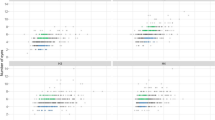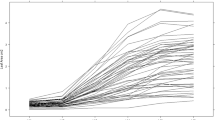Abstract
This work was undertaken to compare the tuber yields, vegetative vigor and uniformity of seedling transplants obtained from different breeding methods. Twenty hybrid families from different groups of crosses involving 4x clones and 2x Phureja-haploid Tuberosum hybrids; 4x × 4x, 4x × 2x (FDR), 4x × (4x × 2x), and (4x × 2x) × (4x × 2x) and eleven open pollinated families from 4x clones, and 4x hybrids from 4x × 2x crosses were compared in a replicated yield trial. Families from 4x × 2x (FDR) crosses were the highest yielding among the hybrid groups having approximately twice the yield of the open pollinated 4x clones. They also were the best group in relation to plant vigor and uniformity. Based on these results, it appears that a good breeding scheme for high-yielding and uniform progeny from true potato seeds is the 4x × 2x hybridization method where the male parent is capable of producing 2n pollen via a first division restitution mechanism.
Resumen
Este trabajo se llevó a cabo para comparar los rendimientos de tubérculos, vigor y uniformidad de plántulas obtenidas por diferentes métodos de mejoramiento. Veinte familias de híbridos de diferentes grupos de cruzas que incluyeron clones 4x e híbridos 2x Phureja-haploide Tuberosum; 4x × 4x, 4x × 2x (FDR), 4x × (4x × 2x) y (4x × 2x) × (4x × 2x), y once familias de polinización abierta de clones 4x e híbridos 4x de cruzas 4x × 2x fueron comparados en un ensayo de rendimiento con repeticiones. Las familias provenientes de cruzas 4x × 2x (FDR) fueron las más rendidoras entre los grupos de híbridos y duplicaron aproximadamente el rendimiento de los clones 4x de polinización abierta. Fueron también el mejor grupo en relación al vigor y uniformidad. En base a estos resultados es aparente que un buen esquema de mejoramiento para obtener una progenie de alto rendimiento y uniforme, a partir de semilla botánica de papa, es el método de hibridación 4x × 2x donde el progenitor masculino es capáz de producir polen 2n mediante un mecanismo de restitución nuclear en la primera división meiótica.
Similar content being viewed by others
Literature Cited
Accatino, P. and P. Malagamba. 1982. Potato Production from True Seed. International Potato Center, Lima, Peru. 20 pp.
de Jong, H., G.C.C. Tai, W.A. Russell, G.R. Johnston and K.G. Proudfoot. 1981. Yield potential and genotype-environment interactions of tetraploid-diploid (4x-2x) potato hybrids. Am Potato J 58:191–199.
Glendinning, D.R. 1976. Neo-Tuberosum: new potato breeding material. 4. The breeding system of Neo-Tuberosum, and the structure and composition of the Neo-Tuberosum gene pool. Potato Res 19:27–36.
Hermsen, J.G.Th. 1979. Breeding for apomixis in potato: pursuing an Utopian scheme? CIP Report of a Planning Conference on the Production of Potatoes from True Seed. Manila, Philippines, pp. 132–150.
Li, J.H. Prospects for the use of true seed to grow potato. In: Research for the Potato in the Year 2000. (1982). Hooker, W.J., ed. CIP, Lima, Peru. In press.
McHale, N.A. and F.I. Lauer. 1981. Breeding value of 2n pollen diploid from hybrids and Phureja in 4x-2x crosses in potatoes. Am Potato J 58:365–373.
Mendiburu, A.O., S.J. Peloquin and D.W.S. Mok. 1974. Potato breeding with haploids and 2n gametes. In: Haploids in Higher Plants: Advances and Potential. Kasha, K.J., ed. Proceedings of the First International Symposium. The University of Guelph, Guelph, Ontario, Canada, pp. 249–258.
Mendiburu, A.O. and S.J. Peloquin. 1977. The significance of 2n gametes in potato breeding. Theor Appl Genet 49:53–61.
Mendoza, H. 1979. Preliminary results on yield and uniformity of potatoes grown from true seed. CIP Report of a Planning Conference on the Production of Potatoes from True Seed. Manila, Philippines, pp. 156–172.
Mok, D.W.S. and S.J. Peloquin. 1975. Breeding value of 2n pollen (diplandroids) in tetraploid × diploid crosses in potatoes. Theor Appl Genet 46:307–314.
Okwuagwu, C. 1981. Phenotypic variation and cytological analysis of 24-chromosome hybrids for analytical breeding in potato. Ph.D. Thesis, University of Wisconsin, Madison, 170 pp.
Peloquin, S.J. 1979. Breeding methods for achieving phenotypic uniformity. CIP Report of a Planning Conference on the Production of Potatoes from True Seed. Manila, Philippines, pp. 151–155.
Quinn, A.A. and S.J. Peloquin. 1973. Use of experimental tetraploids in potato breeding. Am Potato J 50:415–420.
Author information
Authors and Affiliations
Additional information
Paper No. 2615 from the Laboratory of Genetics. Research supported by the College of Agricultural and Life Sciences; International Potato Center; USDA, CRGO 5901-0410-8-0180-0; and Pan-American Seed Co.
Rights and permissions
About this article
Cite this article
Macaso-Khwaja, A.C., Peloquin, S.J. Tuber yields of families from open pollinated and hybrid true potato seed. American Potato Journal 60, 645–651 (1983). https://doi.org/10.1007/BF02852834
Received:
Issue Date:
DOI: https://doi.org/10.1007/BF02852834




